Return to the main program page.
Return to the Student Reports page.
By Andrew Nguy, Yale University
The “Searching the Way along the Zhijiang: The Sixth Glorisun International Intensive Program on Buddhist Studies,” jointly organized by the Peking University and the Jishan Academy at Mount Kuaiji Institute of Advanced Research on Buddhism, brought over fifty scholars and graduate students from over thirty institutions across the globe from August 9–22, 2023.
The series of events began in Hong Kong where over one hundred international scholars from seventy-six universities presented on an array of topics as part of a rapid two-day inaugural forum entitled “Beyond Civilizational Clash: The Coalescence of Human Civilizations” during August 10–11. The forum was comprised of three conferences entitled “Engaged Buddhism for an Engulfed World: New Perspectives on Humanistic Buddhism”; “Sinification, Globalization or Glocalization?: Paradigm Shifts in the Study of Transmission and Transformation of Buddhism in Asia and Beyond”; and “Buddhism, Science and Technology: Challenges to Religions from a Digitalized World”. At these three simultaneous conferences, panelists discussed Buddhism and its intersections with topics ranging from philology to quantum physics. The intensive program then continued at Jishan Academy in a scenic region of Shaoxing from August 12–22, and was scheduled into two segments. Buzzing with excitement, participants had begun to mingle and discuss their research interests and hobbies with each other even before the welcome dinner. After several years of conducting the intensive programs virtually due to the pandemic, this return to in-person format facilitated much deeper conversations and discussions outside of classes.
During the welcome dinner on August 12, Professor Jinhua Chen (University of British Columbia) welcomed the students and professors, and the students introduced themselves in both English and Mandarin. This bilingual approach continued throughout the intensive program, with meals and breaks filled with a mixture of discussions in Mandarin, English, and sometimes Japanese. To conclude, Chen presented the schedule for the intensive program’s two-week itinerary, and encouraged students to immerse themselves in the Academy’s scholarly atmosphere.
On the following morning of August 13, Chen welcomed students and professors once again. The participants watched a video on the history of the Glorisun Global Network for Buddhist Studies (referred hereafter as Glorisun Global Network), situating the sixth intensive program in the broader context of the Glorisun Foundation’s goals of long-term support for Buddhist Studies as a discipline. A second video highlighted the history of Mount Kuaiji by explaining its connection to the cult of Maitreya Bodhisattva 彌勒佛, and influential past and present Buddhist figures ranging from the monk Zhi Dun 支遁 (314–366) and the early twentieth-century reformer Taixu 太虛 (1890–1947). Aside from the Institute and the adjacent Longhua Monastery 龍華寺, the area’s gem is the Palace of the Tuṣita Heaven 兜率天宮 which houses the world’s largest indoor Maitreya statue of thirty-three meters tall.
Following Chen’s introduction, Professor Robert Sharf (University of California, Berkeley) remarked on the impact of the Glorisun Global Network and From the Ground Up: Buddhism and East Asian Religions (FROGBEAR) program on funding opportunities and research projects in Buddhist Studies. Sharf highlighted Chen’s visionary role in instigating the entire project, which sought to break down regional walls in Buddhist Studies between American, European, Chinese, and Japanese scholars.
“The fact that this is happening is of tremendous value for everyone,” said Sharf.
Then, Professor Barend ter Haar (University of Hamburg) echoed Sharf’s comments on the importance of going to new places, meeting new friends, and especially the importance of meeting and interacting with those who speak a different language.
“It starts here, but it doesn’t end here,” ter Haar said about the friendships which would form during the intensive program and strengthen in the years to come.
Professor Imre Galambos (Professor Emeritus of Chinese Studies of University of Cambridge, Qiushi Distinguished Professor of Zhejiang University) noted that both himself and his students at Cambridge benefited tremendously from participating in programs sponsored by Glorisun. Focusing on the span of the program over the past several years, Galambos recalled how the programming had enriched the experiences of an entire generation of Buddhist Studies scholars.
“You’re going to be colleagues and helping each other,” Galambos said, “These are the people you will be working with. This is not about this next week; this is about the next twenty or thirty years.”
Lastly, Professor Kate Crosby (University of Oxford) discussed the legacy of the late Stefano Zacchetti, a founding member of the Glorisun Global Network. In regards to the program itself, Crosby hoped to bring China into the conversation of Theravāda Studies which had been historically divided into Southeast Asian Theravāda and Pāli Studies.
“China is missing in the picture of Theravāda Buddhism,” Crosby said.
Addressing the students, Crosby expressed her hopes that the next generation of scholars in the program would eventually surpass and overturn the instructors in the program in furthering Buddhist Studies. Throughout the opening ceremony, speakers emphasized the program’s career-long and generation-long impact, citing the lasting change it has produced in prior iterations.
In the final address, Professor He Huanhuan何歡歡 (Zhejiang University) welcomed all of the students and professors to Hangzhou, which marked as the start of teaching for segment one.
In the first guest lecture, “To Paint the Unpaintable: Indian and Chinese Notions of Emptiness Merged in Ancient Chinese Paintings,” He argued for a five-stage shift in Buddhist art, beginning from devotional Buddhist art to its incorporation in a greater natural landscape. Throughout this process, He described a shift towards Buddhist Sinicization and secularization in which Buddhist deities eventually became incorporated into characters in a painting to express an idea, rather than as objects of devotion.
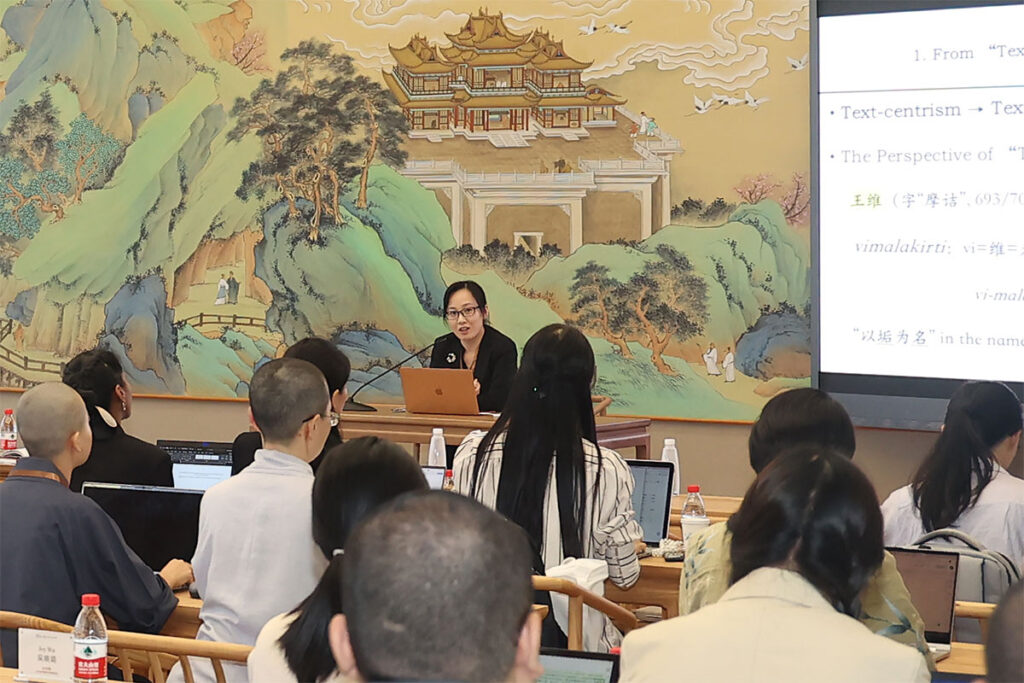
Guest lecture by Professor He Huanhuan. Photo by Jishan Academy, Mount Kuaiji Institute of Advanced Research on Buddhism. Republished with permission.
After lunch, Galambos began his seminar, “Manuscripts and Lay Believers along the Silk Road,” that analysed various manuscript recovered from northwest China sites, and explored how holistic study of manuscripts need to zoom out culturally and engage with traditions and cultures outside of the Sinosphere. From his lectures and exercises, students honed their skills by looking closely at the materiality of the manuscripts rather than just at the words themselves. In other sessions with Galambos, he invited students to practice reading the manuscripts and translate the colophons. After becoming familiar with a variety of manuscript formats such as scroll, concertina, and codex, students could better appreciate the nuances of each physical form.
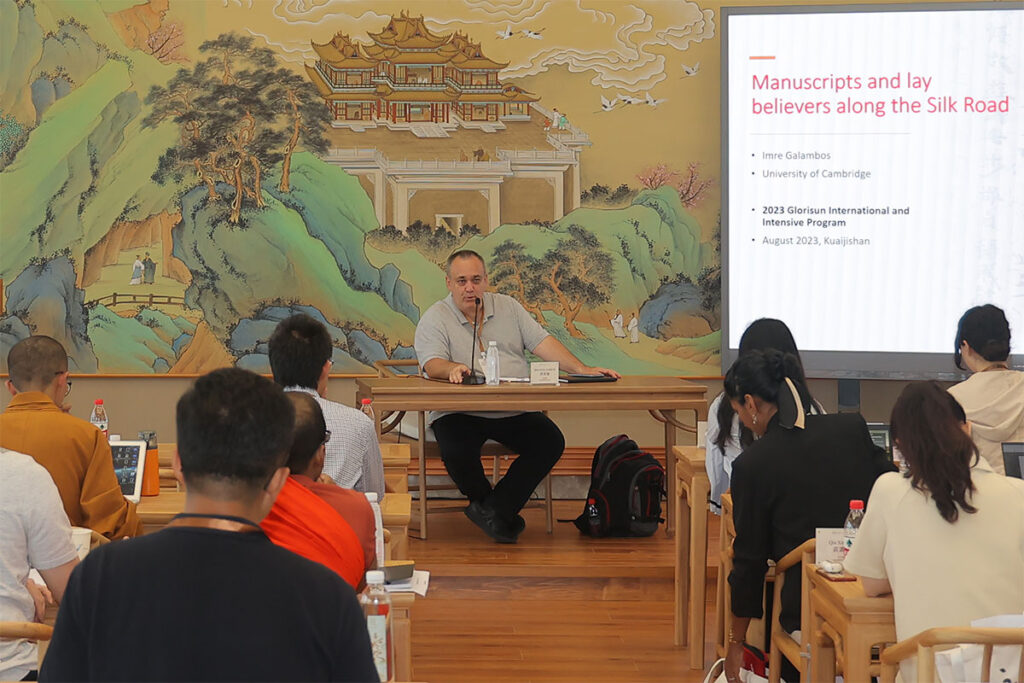
Seminar session led by Professor Imre Galambos. Photo by Jishan Academy, Mount Kuaiji Institute of Advanced Research on Buddhism. Republished with permission.
To end the day, Crosby delivered the first lecture of her seminar, “Theravada Meditation: Transforming and Transformed,” which was an engaging introduction to the rich variety and complexity of meditative traditions in pre-modern Theravāda across South and Southeast Asia. Her session was particularly interactive where she invited students to try their best and follow along to briefly experience what it would be like to meditate using the methods taught in Theravāda Buddhism.
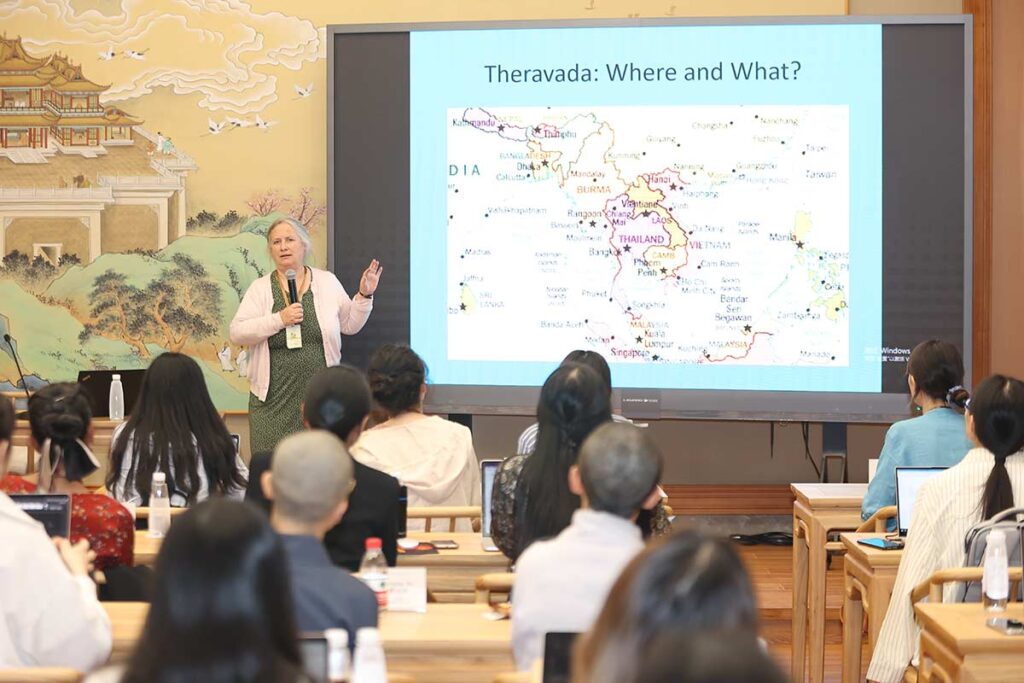
Seminar session led by Professor Kate Crosby. Photo by Jishan Academy, Mount Kuaiji Institute of Advanced Research on Buddhism. Republished with permission.
The second day featured two lectures from Sharf for his seminar on “Thinking through Chan Buddhism,” which contextualized Chan Buddhism in the philosophical and religious culture of Tang-dynasty Buddhism. Through his sessions, students learned how to better appreciate and understand Chan Buddhist stories (gong’an 公案) which—despite being described as nonsensical and anti-intellectual—are carefully crafted to provide a unique answer to doctrinal problems in the Chinese Buddhist tradition.
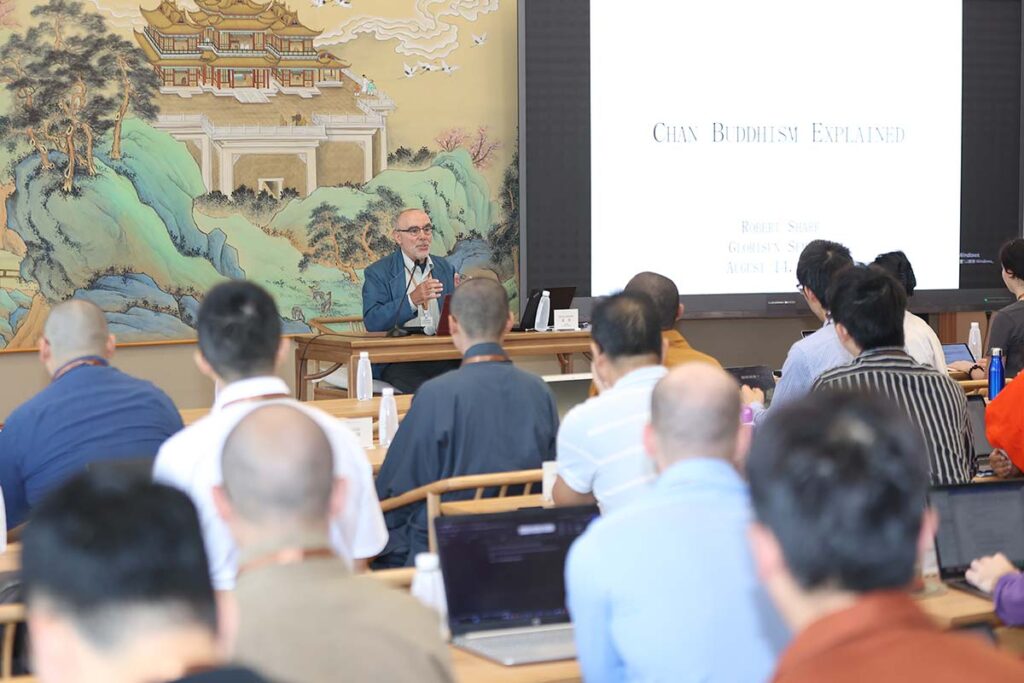
Seminar session led by Professor Robert Sharf. Photo by Jishan Academy, Mount Kuaiji Institute of Advanced Research on Buddhism. Republished with permission.
The intensive program’s segment one concluded with presentations from two guest lecturers. Professor Li Ling李翎 (Sichuan University) discussed the etymology and difference between caitya and stūpa in her lecture, “Construction of Caitya and the Cultural Origins”. Through copious amounts of images, videos, and diagrams, Li demonstrated how cave temples were carefully designed and constructed. Professor Chen Jidong 陳繼東 (Aoyama Gakuin University) presented two lectures on the notion of a “school” or “sect” (zong 宗) in Chinese Buddhism and its relation to Japanese classifications. Chen Jidong argued that while the notion of schools—especially the existence of eight distinct schools—in Chinese Buddhism is attributed to Japanese models, the late-Qing Chinese lay Buddhist Yang Wenhui 楊文會 (1837–1911) had also discussed a system of “Eight Schools and Two Practices” (bazong erxing 八宗二行) which overlapped with but was not identical to the Eight Schools proposed in Japanese Buddhist circles.

Guest lecture by Professor Li Ling. Photo by Jishan Academy, Mount Kuaiji Institute of Advanced Research on Buddhism. Republished with permission.
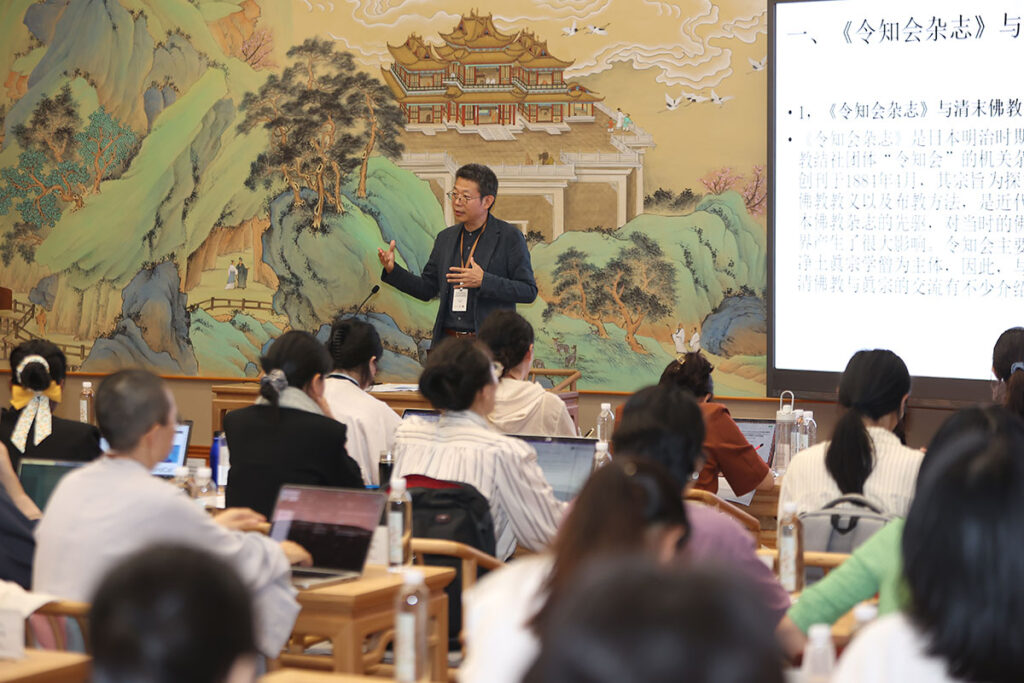
Guest lecturer Professor Chen Jidong. Photo by Jishan Academy, Mount Kuaiji Institute of Advanced Research on Buddhism. Republished with permission.
Jinhua Chen began the second segment of the intensive program with a challenging assignment on sightreading a preface in classical Chinese, putting participants to the test. His expertise and dual status as author of the preface poised him to guide students and elaborate on the literary allusions in the text. His lectures, which continued for the rest of the day, traced the history of Buddhism and its relationship with economics and politics. Throughout his lectures, Chen drew parallels to Christian Europe and engaged students with discussions on how these relationships between secular and religious institutions persist in their own lives, such as the religious origins of many post-secondary educational institutions in the United States.
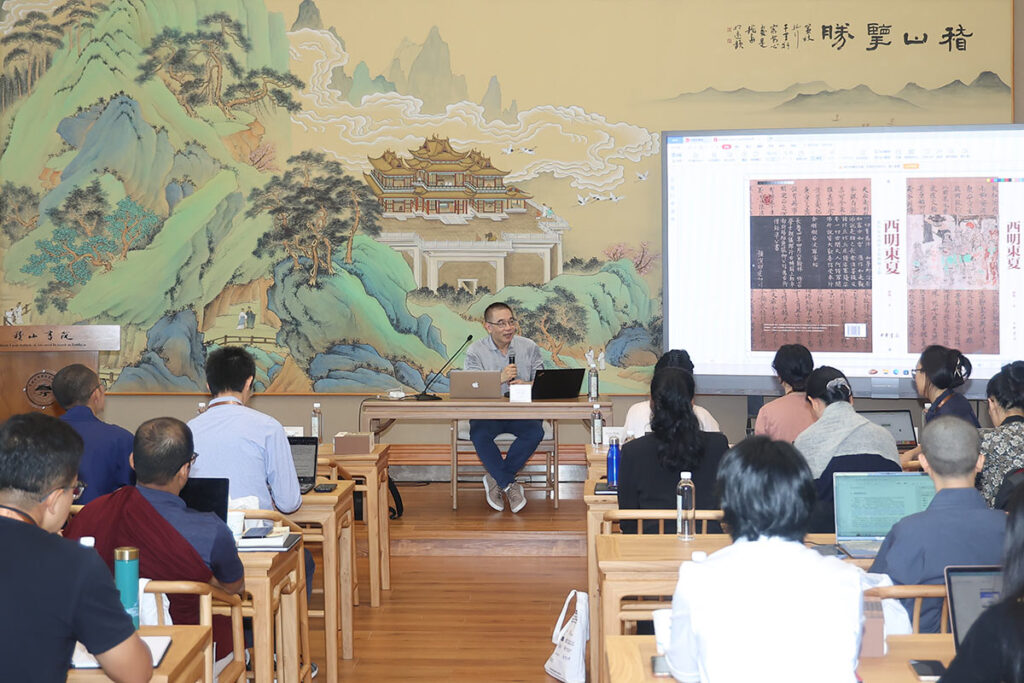
Seminar session led by Professor Jinhua Chen. Photo by Jishan Academy, Mount Kuaiji Institute of Advanced Research on Buddhism. Republished with permission.
Professor Barend ter Haar’s seminar entitled “Alternative Sources for Studying Local Religious Life: Sutra Colophons (Song-Yuan) and Late Ming Precious Scrolls” emphasized the need to expand studies of Buddhism to include religious activities and organizations on the margins of a conservative “Buddhism.” Through his lectures and reading exercises in classical Chinese, students learned how to identify authors of specific religious groups and look beyond sources featuring the Buddhism of an elite monastic minority to appreciate the wider range of Buddhism.
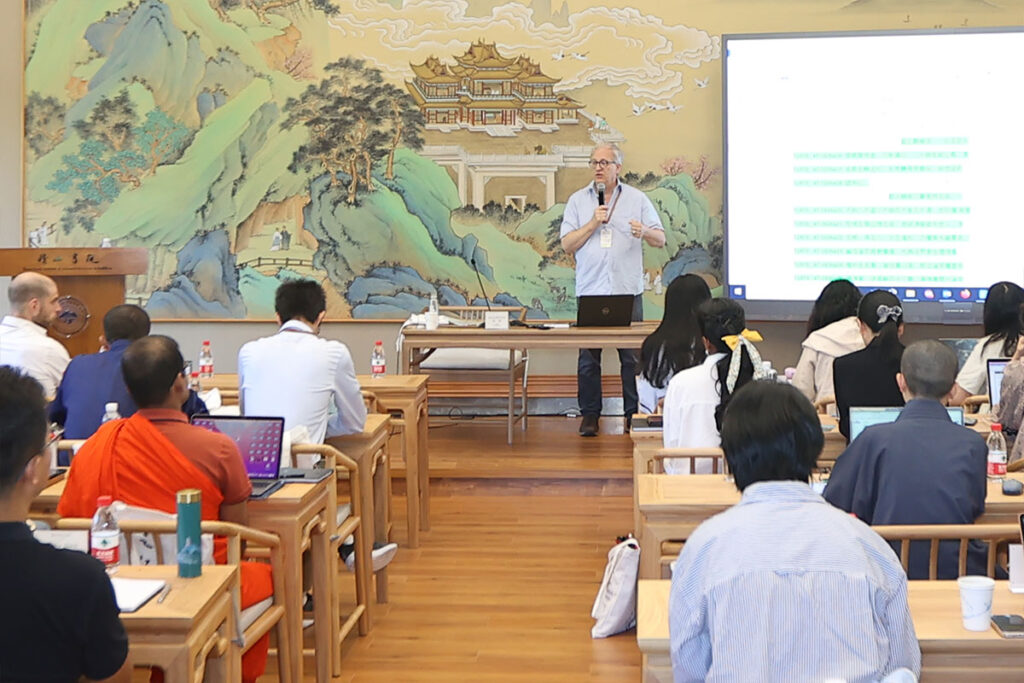
Seminar session led by Professor Barend ter Haar. Photo by Jishan Academy, Mount Kuaiji Institute of Advanced Research on Buddhism. Republished with permission.
The second segment also included a guest lecture by Venerable Professor Sheng Kai 聖凱 (Tsinghua University) entitled “Transformation of Tang Buddhism under the Perspectives of Military Conflicts,” which urged students to see Tang Buddhism in a new light by revisiting assumptions regarding Buddhist involvement in the conflicts, and re-examining turmoil closely linked to Buddhist decline. In addition, an unscheduled, last-minute lecture by Professor Zhang Wenliang 張文良(Renmin University) introduced students to the growing field on Life and Death Studies 生死學. Contextualizing his current research, Zhang recounted his academic career, from his doctoral program at the University of Tokyo to his mother’s passing, which catalyzed his interest in the academic study of life and death. In the final guest lecture delivered by Professor Sun Yinggang 孫英剛 (Zhejiang University), participants reconsidered the complex relationship between state and church in the context of Buddhism in medieval China in his talk “Imperial Courts under the Buddha’s Light: Religious Aspects of Medieval Politics.”

Guest lecture by Venerable Professor Sheng Kai. Photo by Jishan Academy, Mount Kuaiji Institute of Advanced Research on Buddhism. Republished with permission.

Guest lecturer Professor Zhang Wenliang. Photo by Jishan Academy, Mount Kuaiji Institute of Advanced Research on Buddhism. Republished with permission.
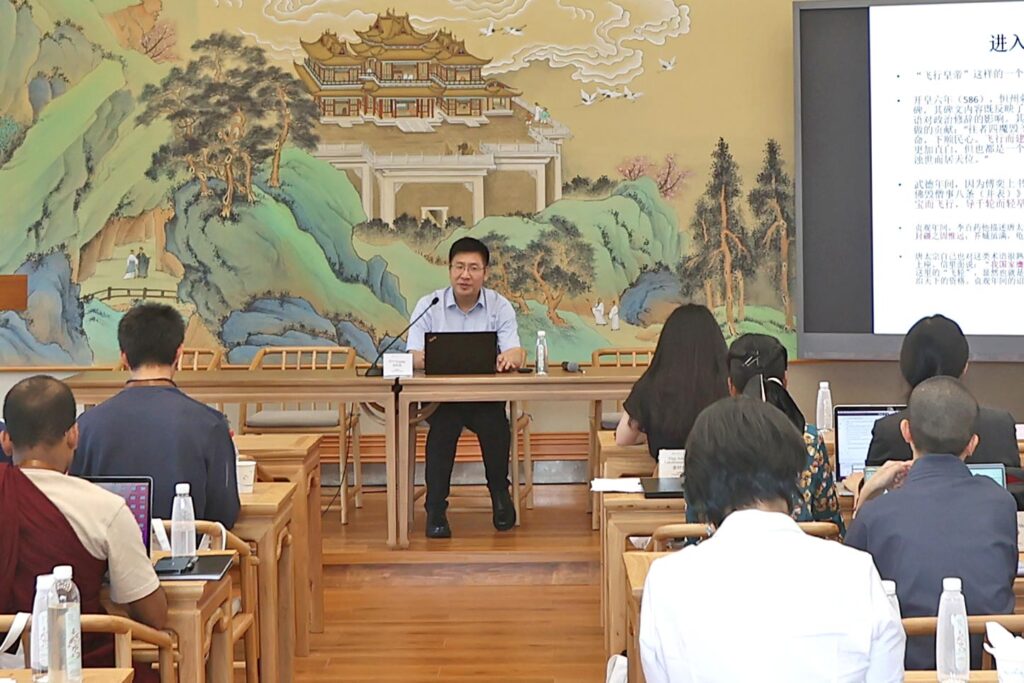
Guest lecturer Professor Sun Yinggang. Photo by Jishan Academy, Mount Kuaiji Institute of Advanced Research on Buddhism. Republished with permission.
Throughout both segments, students bonded during breaks and deepened their understanding of each other’s research. Especially valuable were the small-group conversations with professors where students often followed up on topics discussed in class. For recreation, students often played ping-pong in the evenings and walked around the grounds. The idyllic atmosphere of the lake and mountains coupled with the abundant and the delicious vegetarian cuisine helped ease the participants into a deep study of Buddhism.
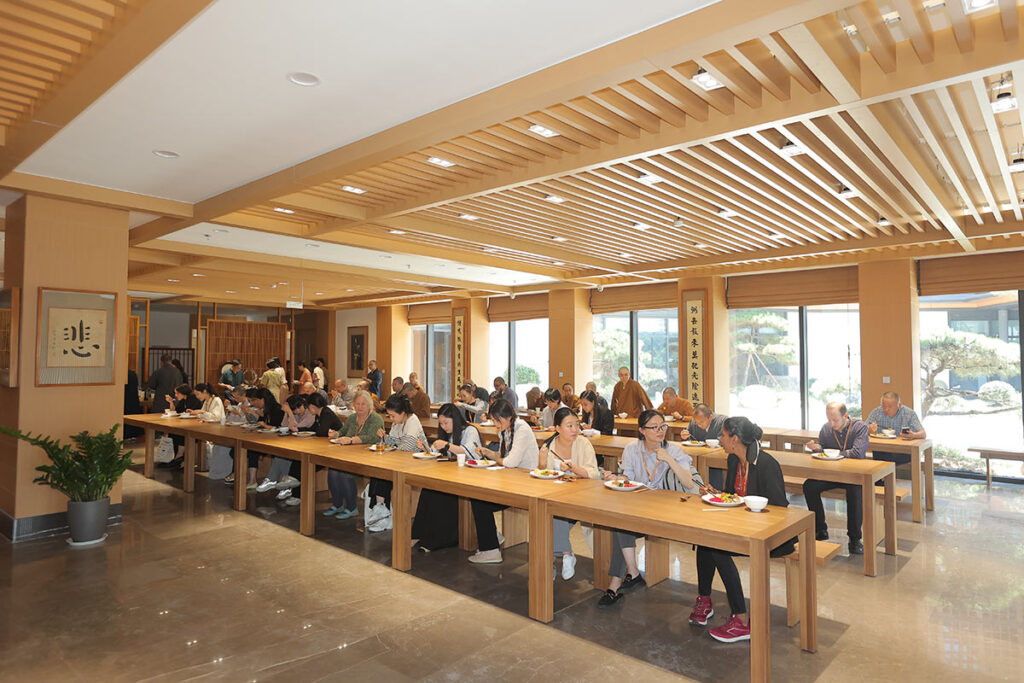
Meals at dining hall. Photo by Jishan Academy, Mount Kuaiji Institute of Advanced Research on Buddhism. Republished with permission.
Fueled by ample feedback and scholarly exchange, a total of fifteen students presented their work at the Student Forum on August 19 and 20. Students gained valuable experience in presenting their research as well as in moderating and responding to each other’s viewpoints. The first panel, chaired by doctoral student Qi Liu 劉琦(McGill University), broadly addressed the topic of texts. This diverse panel included presentations by Lai Chon Iat 黎俊溢(Tsinghua University), who introduced the compilation of the Nili jing 泥犁經[Sūtra on the Hells] and its relationship to the medieval Chinese imagination of hell; Lin Xuna 林旭娜 (Peking University), who honed in on one specific word—chu 出—and used a combination of qualitative and quantitative methods to determine its range of meanings and usages in Buddhist inscriptions; Madipola Wimalajothi Thero (University of Hong Kong), who presented on the composition of the Samantapāsādikā; and Zhiguo Yang 楊志國(Fudan University), who presented on manuscripts of the Baoyun jing 寶雲經[Jewel Cloud Sūtra] from Dunhuang. Afterwards, postdoctoral scholar Zhouyuan Li 李周淵(Zhejiang University) responded to each panelist as discussant.

Panel 1 participants. Photo by Jishan Academy, Mount Kuaiji Institute of Advanced Research on Buddhism. Republished with permission
The second panel, chaired by Elena Ezhova (University Paris Sciences et Lettres), focused on doctrine and featured presentations by Rulü Shi 如律 (China Buddhist Academy) and Brianna Morseth (Chinese University of Hong Kong). Shi presented on the Foxing lun 佛性論 [Buddha-nature Treatise] attributed to Vasubandhu (Shiqin 世親, fl. ca. fourth or fifth century), and also delivered a presentation on behalf of Xinglei Shi 釋行蕾 (Minnan Buddhist College) on Paramārtha (499–569)’s Yogācara thought. Morseth’s presentation titled, “Mysticism and the Nebulous World of Religious Experience: A Critical Review and Phenomenological Study of Nianfo and Huayan Buddhist Meditation,” brought premodern sources in conversation with contemporary self-reported experiences to further elucidate the ways in which religious experiences impact an individual. As discussant, ter Haar provided both general comments and guidance on how to improve one’s research overall as well as detailed feedback specific to each paper.
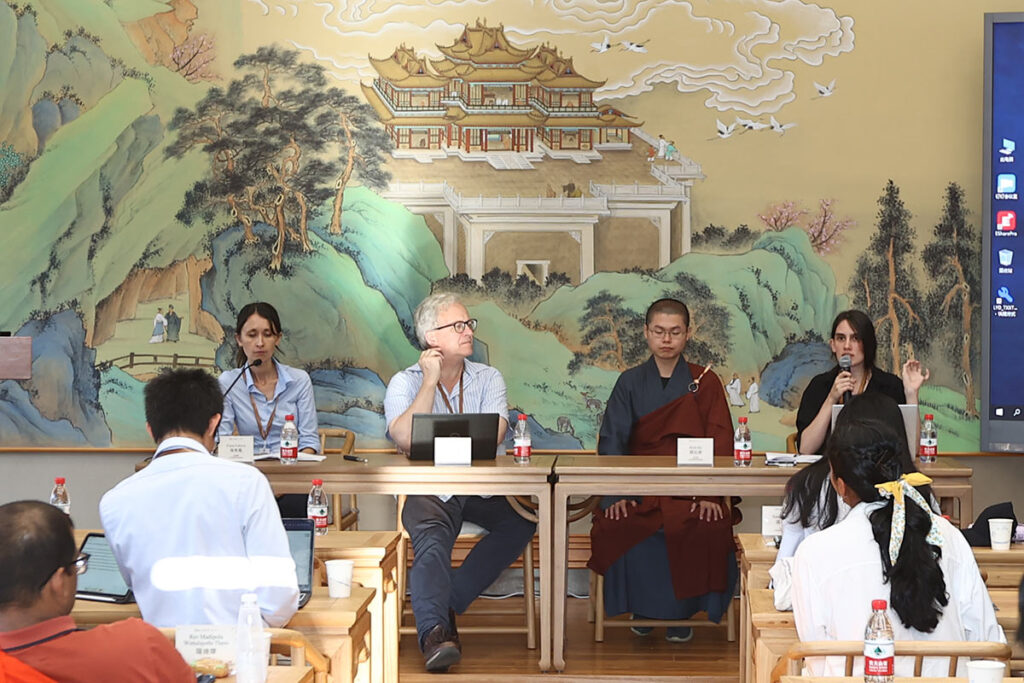
Panel 2 participants. Photo by Jishan Academy, Mount Kuaiji Institute of Advanced Research on Buddhism. Republished with permission.
The third panel, chaired by recent graduate Andrew Nguy (Yale University), focused on the transmission of monastic knowledge and featured presentations by Xueqi Zhang 張雪琪 (Nanjing University) on early Buddhist encyclopedias; Li Zhouyuan 李周淵 (Zhejiang University) on the printing of Buddhist canons during the Southern Song dynasty 南宋 (1127–1279), and Leo Koenig (University of Hamburg) on Sanskrit education in modern Chinese Buddhism, with discussant Yingxian Tan 談穎嫻 (Hebrew University of Jerusalem) providing responses.
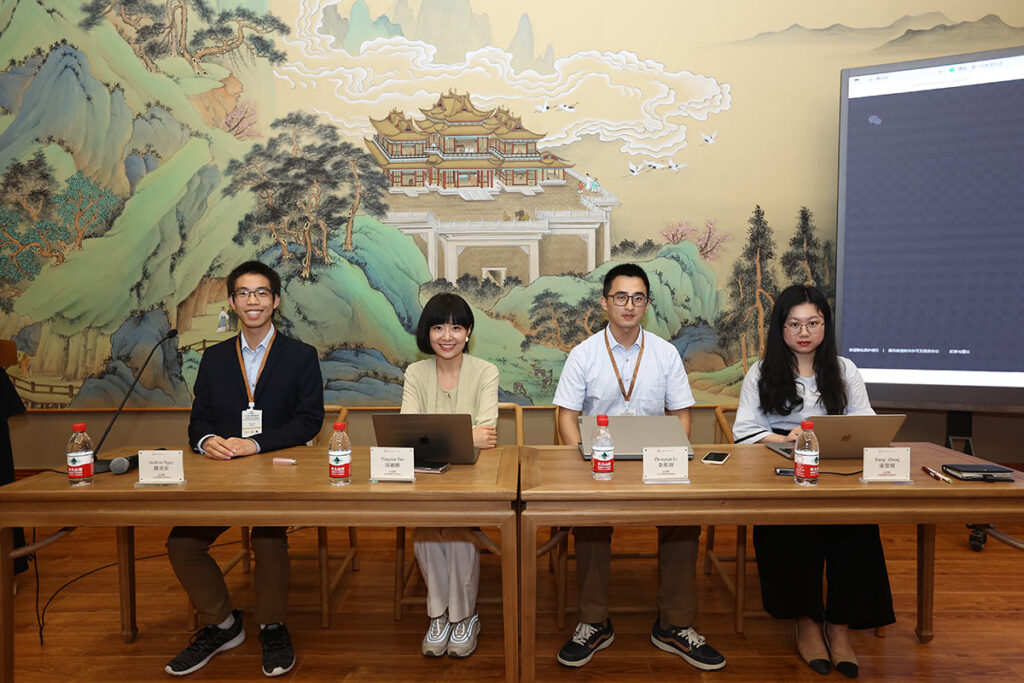
Panel 3 participants. Photo by Jishan Academy, Mount Kuaiji Institute of Advanced Research on Buddhism. Republished with permission.
The fourth panel, chaired by QJ Zheng 鄭麒駿 (École Pratique des Hautes Études), delve into historical and social aspects. Zhanpeng Yang 楊戰朋 (Lingnan Normal University) introduced the unique Buddhist culture of the Leizhou Peninsula through the lens of Ming 明 (1368–1644) and Qing 清 (1644–1911) dynasty gazetteers. Then, Hanruo Zhang 張含若 (Princeton University) elucidated the relationships between literati and Buddhist societies in the Northern Song dynasty 北宋 (960–1126). Finally, Yingxian Tan presented on the figure of “Prince Moonlight” (yueguang tongzi 月光童子) and his influence on the religion and politics of the Sui dynasty 隋 (581–618). As discussant, postdoctoral scholar Chongzhou Zhang 張重洲 (Tsinghua University) provided comments, and from the audience, Professor Sun Yinggang 孫英剛 (Zhejiang University) responded directly to Tan on the topic of Prince Moonlight, precluding his own talk on the topic as part of a lecture on depictions of cakravartin in early Buddhist art and texts.
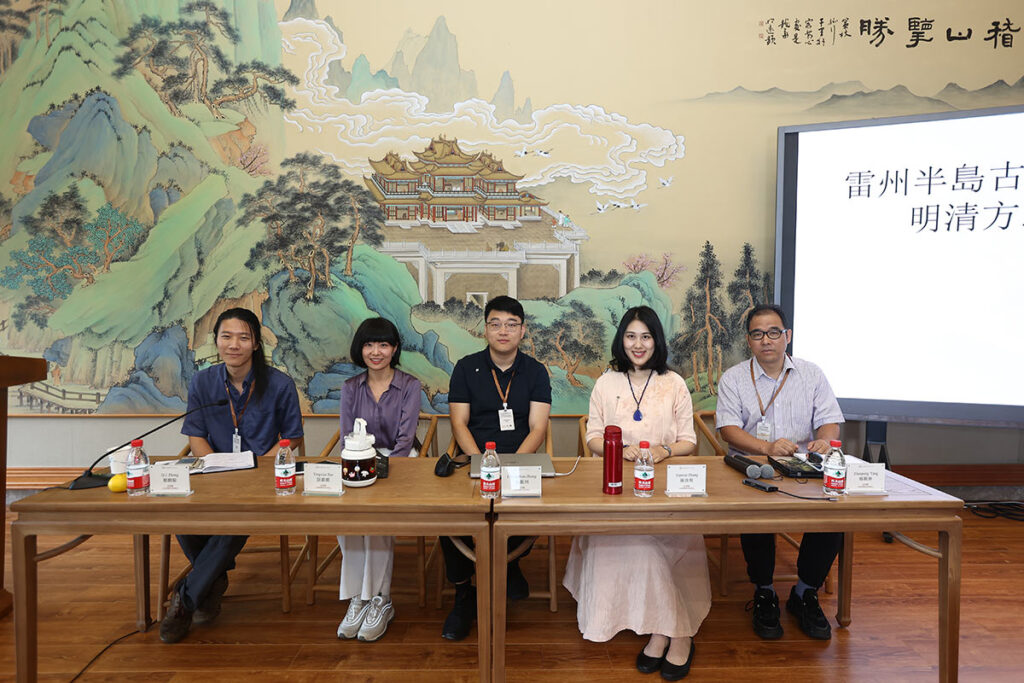
Panel 4 participants. Photo by Jishan Academy, Mount Kuaiji Institute of Advanced Research on Buddhism. Republished with permission.
In the final panel, chaired by Liting Wang 王麗婷 (University of California, Los Angeles), three students presented on the interplay between ritual and art with Sun as discussant. To begin, recent graduate Junfu Wong 黃君榑 (University of Cambridge) presented his reading of rosters in stone stelae as a snapshot of an idealized seating arrangement for the performance of a ritual. Following Wong’s presentation, Catherine Fan (University of Virginia) presented on the Uṣṇīṣavijayā cult in Dunhuang and artistic depictions of Uṣṇīṣavijayā rituals preserved on the cave walls’ murals. Lastly, Limin Zhang 張利明(Zhejiang University) argued through stylistic analysis that the two metal buddha figures from the Eastern Han 東漢 (25–220) tomb in Xianyang post-date the tomb itself.

Panel 5 participants. Photo by Jishan Academy, Mount Kuaiji Institute of Advanced Research on Buddhism. Republished with permission.
At the closing ceremony on August 20, Venerable Daowu 釋道悟, Vice President of Mount Kuaiji Institute of Advanced Research on Buddhism, introduced and invited student representatives to share their experiences of the intensive program. The representatives recounted their fondest memories and shared their appreciation for all those who made the program possible, beginning with the Glorisun Foundation’s generous sponsorship, to the professors, the administrative staff working behind the scenes, and the cooks in the dining hall. After the students’ remarks, Venerable Daowu invited professors Zhan Ru 湛如(Peking University), ter Haar, and Sun to present certificates of completion. As the night concluded, students lingered to take photos, continued their conversations, and exchanged contact information to stay in touch after the intensive program. While some went on to play ping-pong, Venerable Daowu and Andrew Nguy shared several songs on guqin 古琴, a Chinese seven-stringed zither, for students who stayed behind.
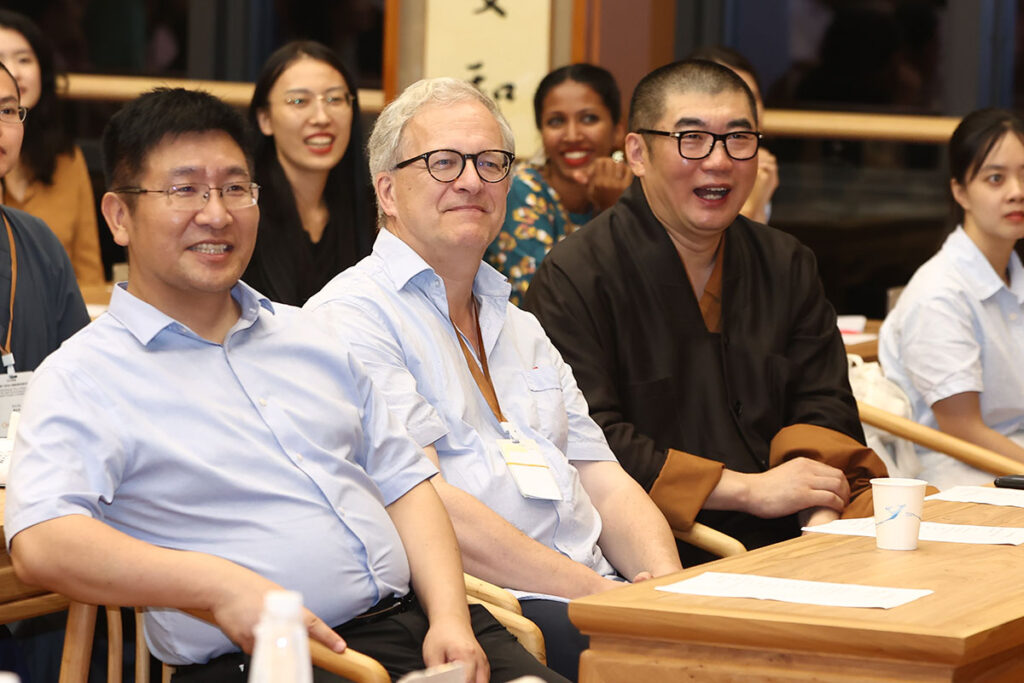
From left: Professor Sun Yinggang, Professor Barend ter Haar, and Venerable Professor Zhan Ru. Photo by Jishan Academy, Mount Kuaiji Institute of Advanced Research on Buddhism. Republished with permission.
The following day was filled with a mix of emotions as some students departed and others went on to field visits in Shaoxing which began at the Palace of Tuṣita Heaven atop the hill of Jishan Academy. In the city, students visited the Lanting Museum of Calligraphy 蘭亭書法博物館, where Wang Xizhi 王羲之(303–361), famed Chinese politician and writer, composed his timeless calligraphic masterpiece. After lunch, during which they enjoyed local delicacies such as stinky tofu, the students roamed through the residence of the revolutionary Chinese writer Lu Xun 魯迅(1881–1936) and other historic buildings.
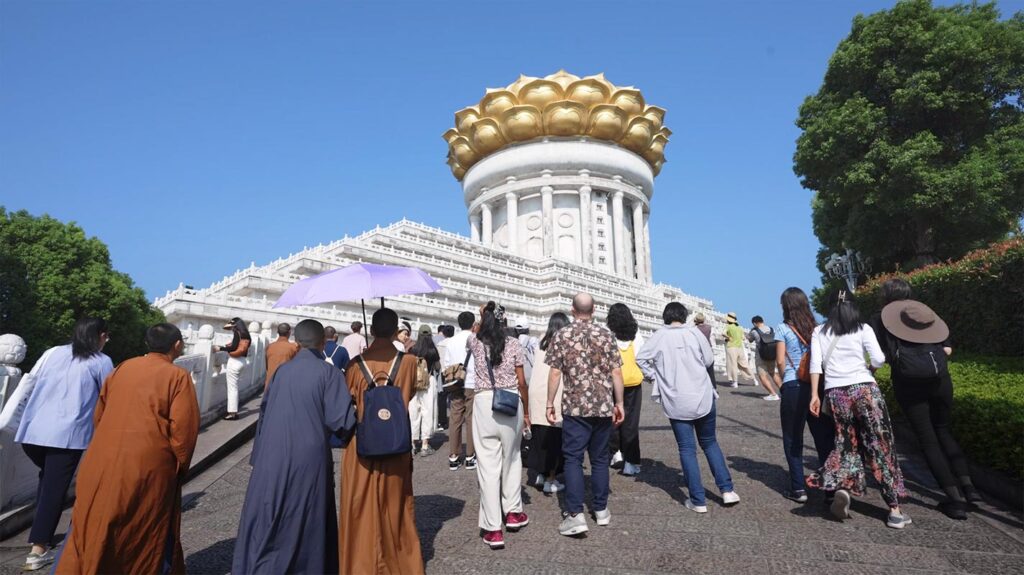
Intensive program students visiting the Palace of Tuṣita Heaven. Photo by Jishan Academy, Mount Kuaiji Institute of Advanced Research on Buddhism. Republished with permission.

Intensive program students visiting the Lanting Museum of Calligraphy. Photo by Jishan Academy, Mount Kuaiji Institute of Advanced Research on Buddhism. Republished with permission.
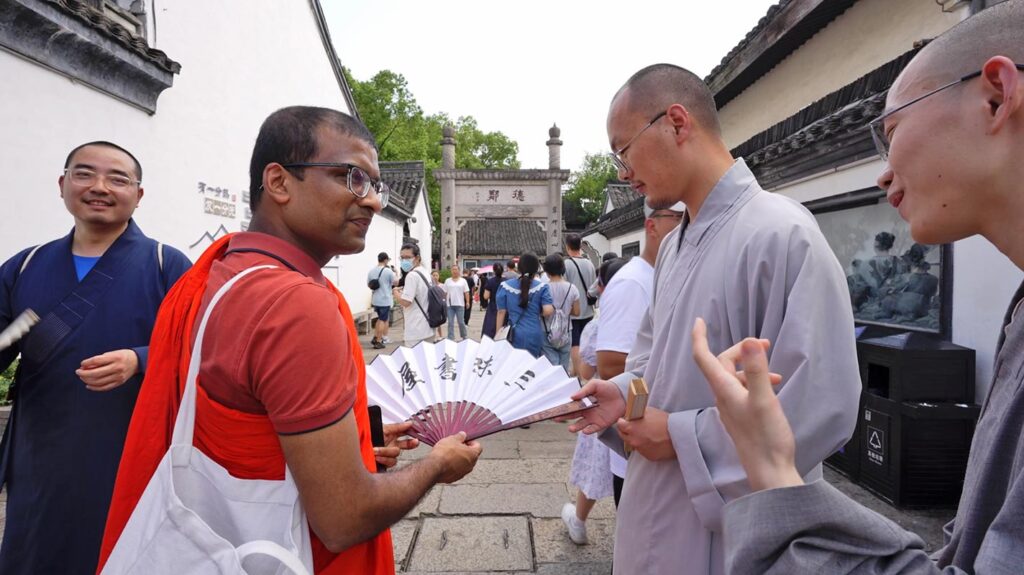
Intensive program students touring historical district of Shaoxing. Photo by Jishan Academy, Mount Kuaiji Institute of Advanced Research on Buddhism. Republished with permission.
To end the day, the remaining students enjoyed a traditional Japanese tea ceremony. As Nguy whisked the matcha while following nagaita-sōkazari 長板総荘り, a procedure involving an elaborate display of utensils on a long, lacquered board, Venerable Daowu guided the experience by leading the guests in accepting and appreciating the sweets, tea, and the utensils used. The demonstration was held in Mandarin, Japanese, and English, highlighting the linguistic and cultural diversity of this year’s participants. After two sessions of tea, students retired for their last night at Jishan Academy.
The two-week academic whirlwind of conferences, lectures, and seminars provided students with a once-in-a-lifetime experience. It was an unprecedented opportunity to network with peers in the field and to learn from a range of esteemed professors, all while living in a cloistered environment optimized for careful study of Buddhism.
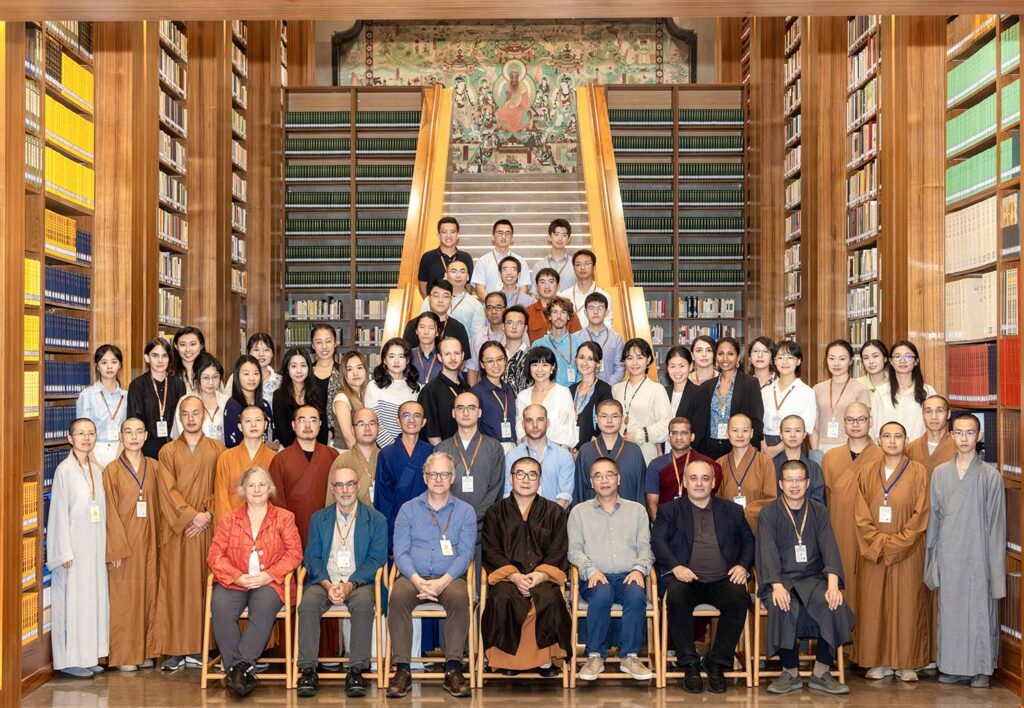
Group photo of “Searching the Way along the Zhijiang: The Sixth Glorisun International Intensive Program on Buddhist Studies”. Photo by Jishan Academy, Mount Kuaiji Institute of Advanced Research on Buddhism. Republished with permission.
Author Bio:
Andrew Nguy is interested in the development of Chinese Buddhist liturgies, especially in the late-imperial period. He earned his BA in Asian Studies at Pomona College and his MA in East Asian Studies at Yale University, where his thesis on Chinese Buddhist rituals and sermons won the Khyentse Award for Excellence in Buddhist Studies. He is currently working as a full-time translator and researcher at the Fo Guang Shan Institute of Humanistic Buddhism.







